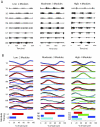Merging of healthy motor modules predicts reduced locomotor performance and muscle coordination complexity post-stroke
- PMID: 20007501
- PMCID: PMC2822696
- DOI: 10.1152/jn.00825.2009
Merging of healthy motor modules predicts reduced locomotor performance and muscle coordination complexity post-stroke
Abstract
Evidence suggests that the nervous system controls motor tasks using a low-dimensional modular organization of muscle activation. However, it is not clear if such an organization applies to coordination of human walking, nor how nervous system injury may alter the organization of motor modules and their biomechanical outputs. We first tested the hypothesis that muscle activation patterns during walking are produced through the variable activation of a small set of motor modules. In 20 healthy control subjects, EMG signals from eight leg muscles were measured across a range of walking speeds. Four motor modules identified through nonnegative matrix factorization were sufficient to account for variability of muscle activation from step to step and across speeds. Next, consistent with the clinical notion of abnormal limb flexion-extension synergies post-stroke, we tested the hypothesis that subjects with post-stroke hemiparesis would have altered motor modules, leading to impaired walking performance. In post-stroke subjects (n = 55), a less complex coordination pattern was shown. Fewer modules were needed to account for muscle activation during walking at preferred speed compared with controls. Fewer modules resulted from merging of the modules observed in healthy controls, suggesting reduced independence of neural control signals. The number of modules was correlated to preferred walking speed, speed modulation, step length asymmetry, and propulsive asymmetry. Our results suggest a common modular organization of muscle coordination underlying walking in both healthy and post-stroke subjects. Identification of motor modules may lead to new insight into impaired locomotor coordination and the underlying neural systems.
Figures








Similar articles
-
The influence of locomotor rehabilitation on module quality and post-stroke hemiparetic walking performance.Gait Posture. 2013 Jul;38(3):511-7. doi: 10.1016/j.gaitpost.2013.01.020. Epub 2013 Mar 13. Gait Posture. 2013. PMID: 23489952 Free PMC article. Clinical Trial.
-
Relationship between gait quality measures and modular neuromuscular control parameters in chronic post-stroke individuals.J Neuroeng Rehabil. 2021 Apr 7;18(1):58. doi: 10.1186/s12984-021-00860-0. J Neuroeng Rehabil. 2021. PMID: 33827607 Free PMC article.
-
Motor module generalization across balance and walking is impaired after stroke.J Neurophysiol. 2019 Jul 1;122(1):277-289. doi: 10.1152/jn.00561.2018. Epub 2019 May 8. J Neurophysiol. 2019. PMID: 31066611 Free PMC article.
-
Gait post-stroke: Pathophysiology and rehabilitation strategies.Neurophysiol Clin. 2015 Nov;45(4-5):335-55. doi: 10.1016/j.neucli.2015.09.005. Epub 2015 Nov 4. Neurophysiol Clin. 2015. PMID: 26547547 Review.
-
Paretic propulsion as a measure of walking performance and functional motor recovery post-stroke: A review.Gait Posture. 2019 Feb;68:6-14. doi: 10.1016/j.gaitpost.2018.10.027. Epub 2018 Oct 25. Gait Posture. 2019. PMID: 30408710 Free PMC article. Review.
Cited by
-
Kinematic-Muscular Synergies Describe Human Locomotion with a Set of Functional Synergies.Biomimetics (Basel). 2024 Oct 13;9(10):619. doi: 10.3390/biomimetics9100619. Biomimetics (Basel). 2024. PMID: 39451826 Free PMC article.
-
Reorganization of Muscle Coordination Underlying Motor Learning in Cycling Tasks.Front Bioeng Biotechnol. 2020 Jul 15;8:800. doi: 10.3389/fbioe.2020.00800. eCollection 2020. Front Bioeng Biotechnol. 2020. PMID: 32760711 Free PMC article.
-
Locomotor adaptation to a soleus EMG-controlled antagonistic exoskeleton.J Neurophysiol. 2013 Apr;109(7):1804-14. doi: 10.1152/jn.01128.2011. Epub 2013 Jan 9. J Neurophysiol. 2013. PMID: 23307949 Free PMC article.
-
Analysis of muscle synergy and gait kinematics during regain of gait function through rehabilitation in a monoplegic patient.Front Hum Neurosci. 2024 Jan 9;17:1287675. doi: 10.3389/fnhum.2023.1287675. eCollection 2023. Front Hum Neurosci. 2024. PMID: 38264349 Free PMC article.
-
Robustness of muscle synergies underlying three-dimensional force generation at the hand in healthy humans.J Neurophysiol. 2012 Apr;107(8):2123-42. doi: 10.1152/jn.00173.2011. Epub 2012 Jan 25. J Neurophysiol. 2012. PMID: 22279190 Free PMC article. Clinical Trial.
References
-
- Balasubramanian CK, Bowden MG, Neptune RR, Kautz SA. Relationship between step length asymmetry and walking performance in subjects with chronic hemiparesis. Arch Phys Med Rehabil 88: 43–49, 2007 - PubMed
-
- Bernstein NA. The Coordination and Regulation of Movements Oxford, UK: Pergamon Press, 1967
-
- Bowden MG, Balasubramanian CK, Neptune RR, Kautz SA. Anterior-posterior ground reaction forces as a measure of paretic leg contribution in hemiparetic walking. Stroke 37: 872–876, 2006 - PubMed
Publication types
MeSH terms
Grants and funding
LinkOut - more resources
Full Text Sources
Other Literature Sources
Medical

